Sir John Monash, Personal Files Book 12, 2 May - 31 May 1916, Part 2
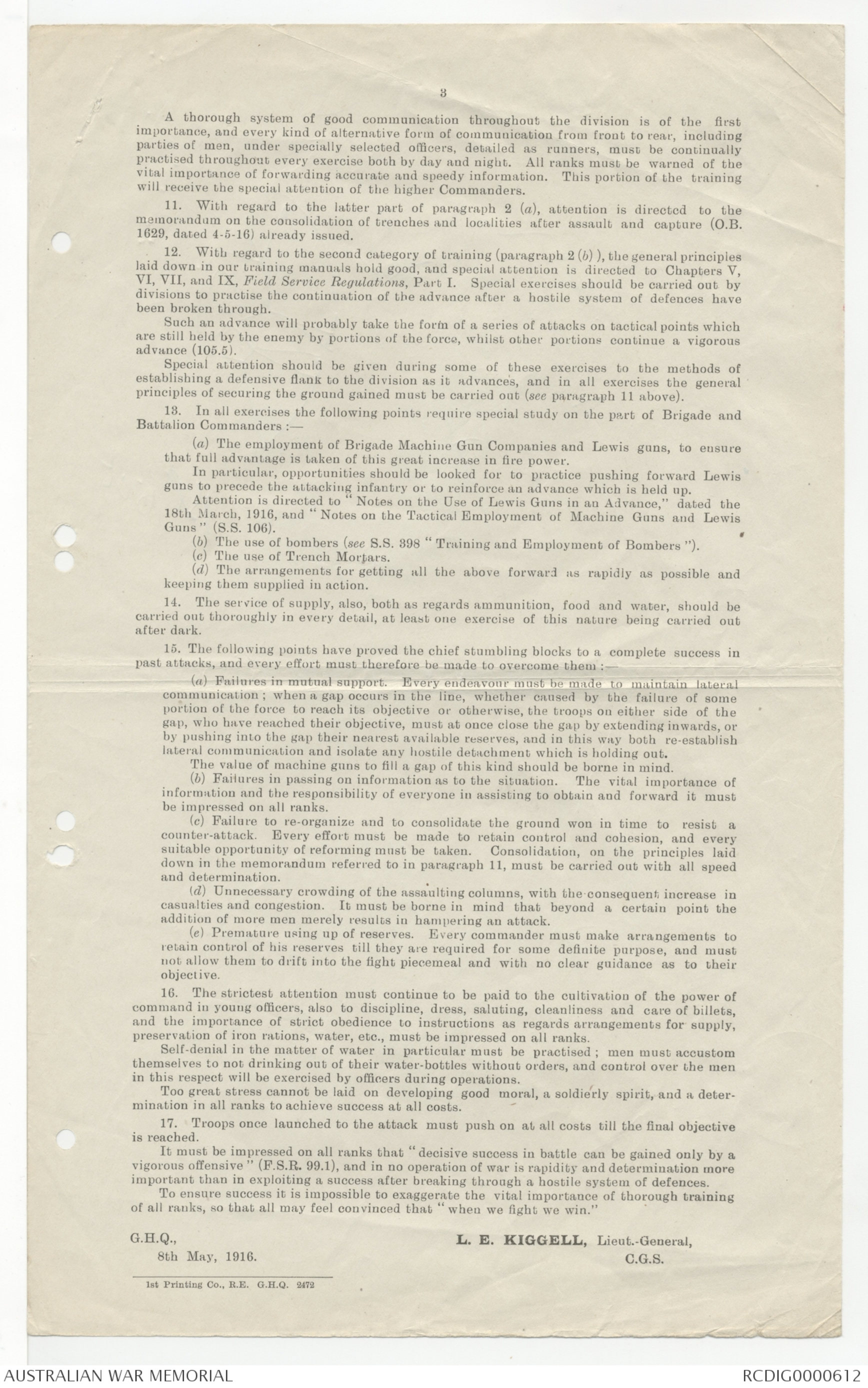
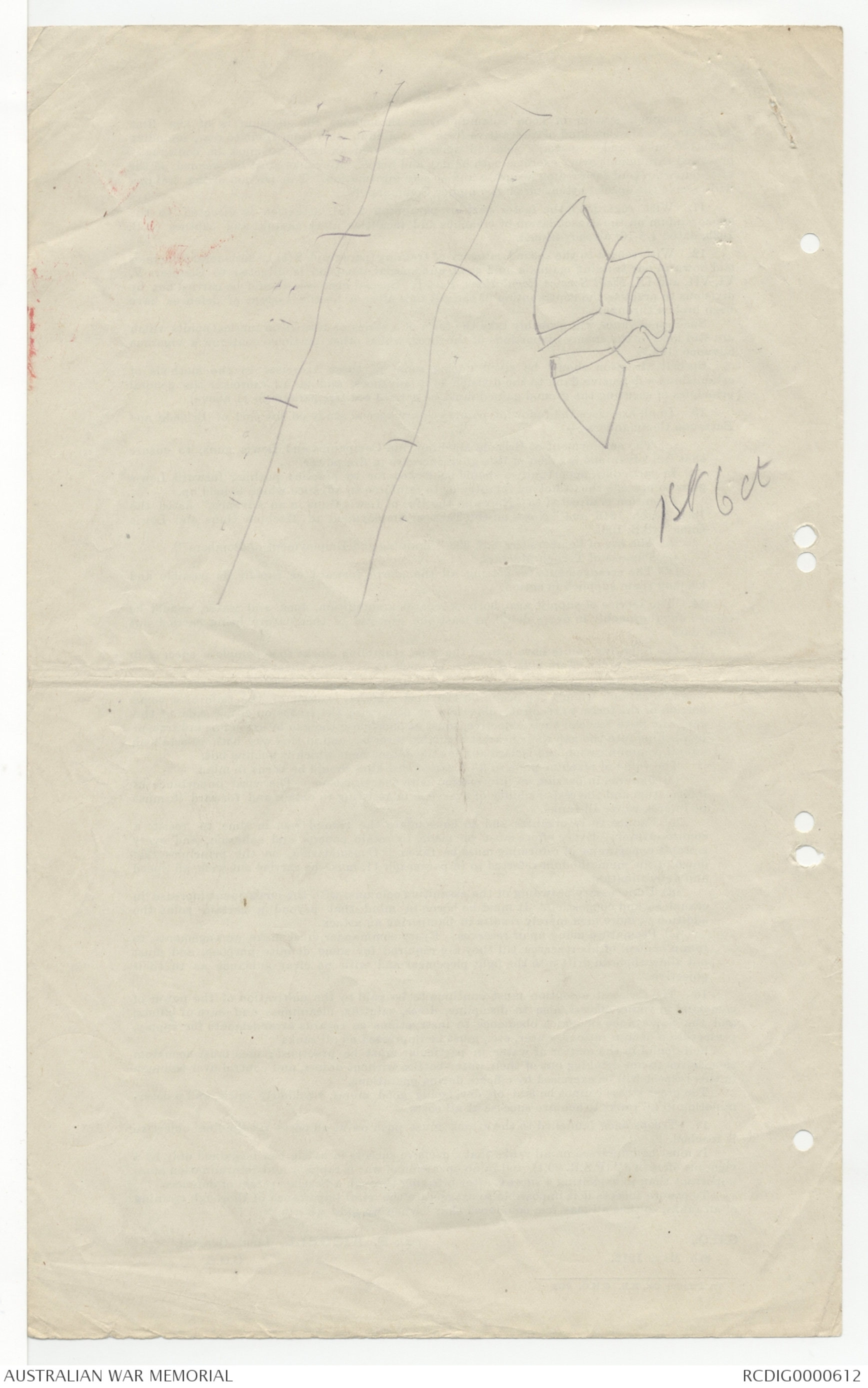
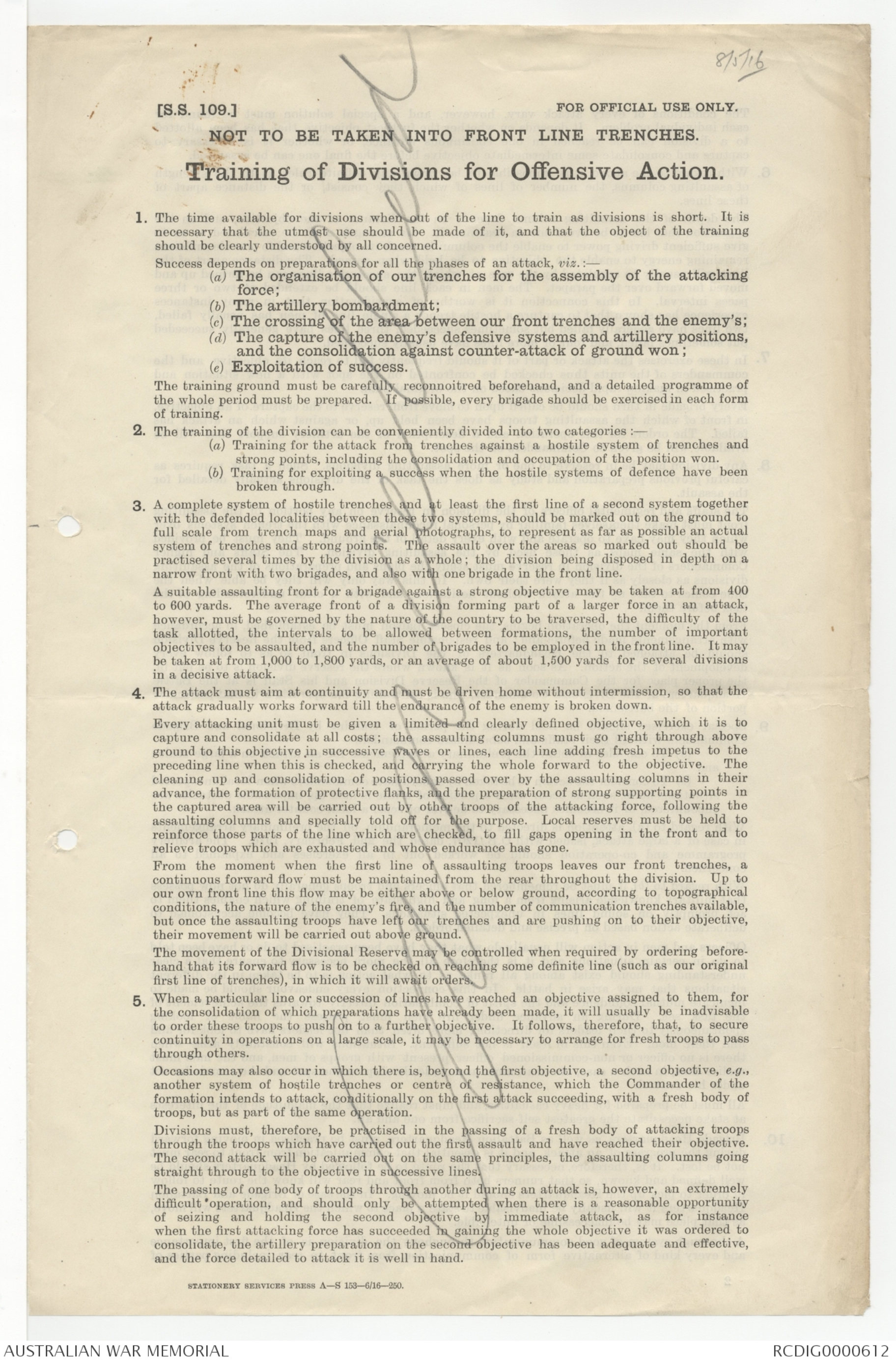
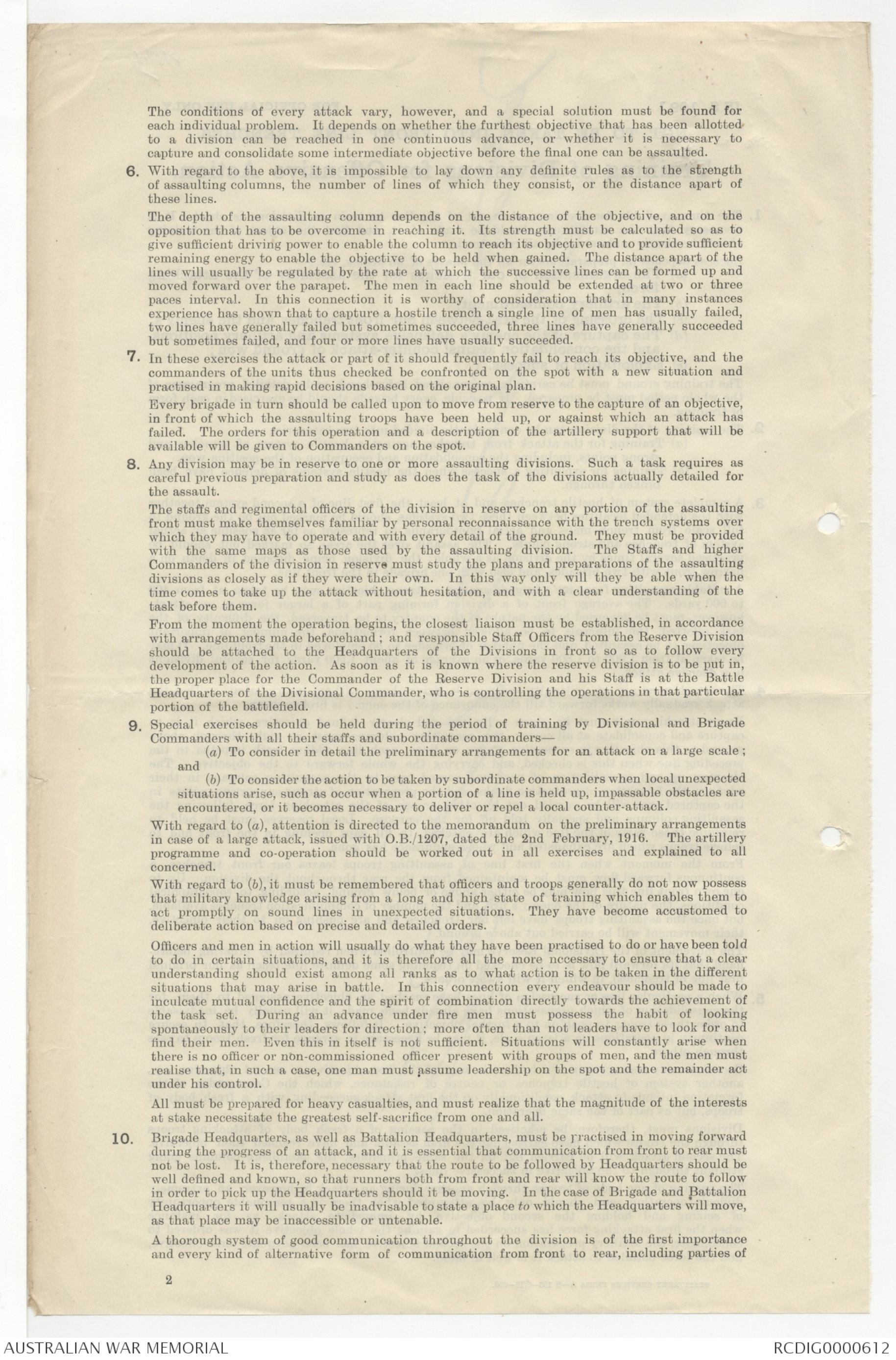
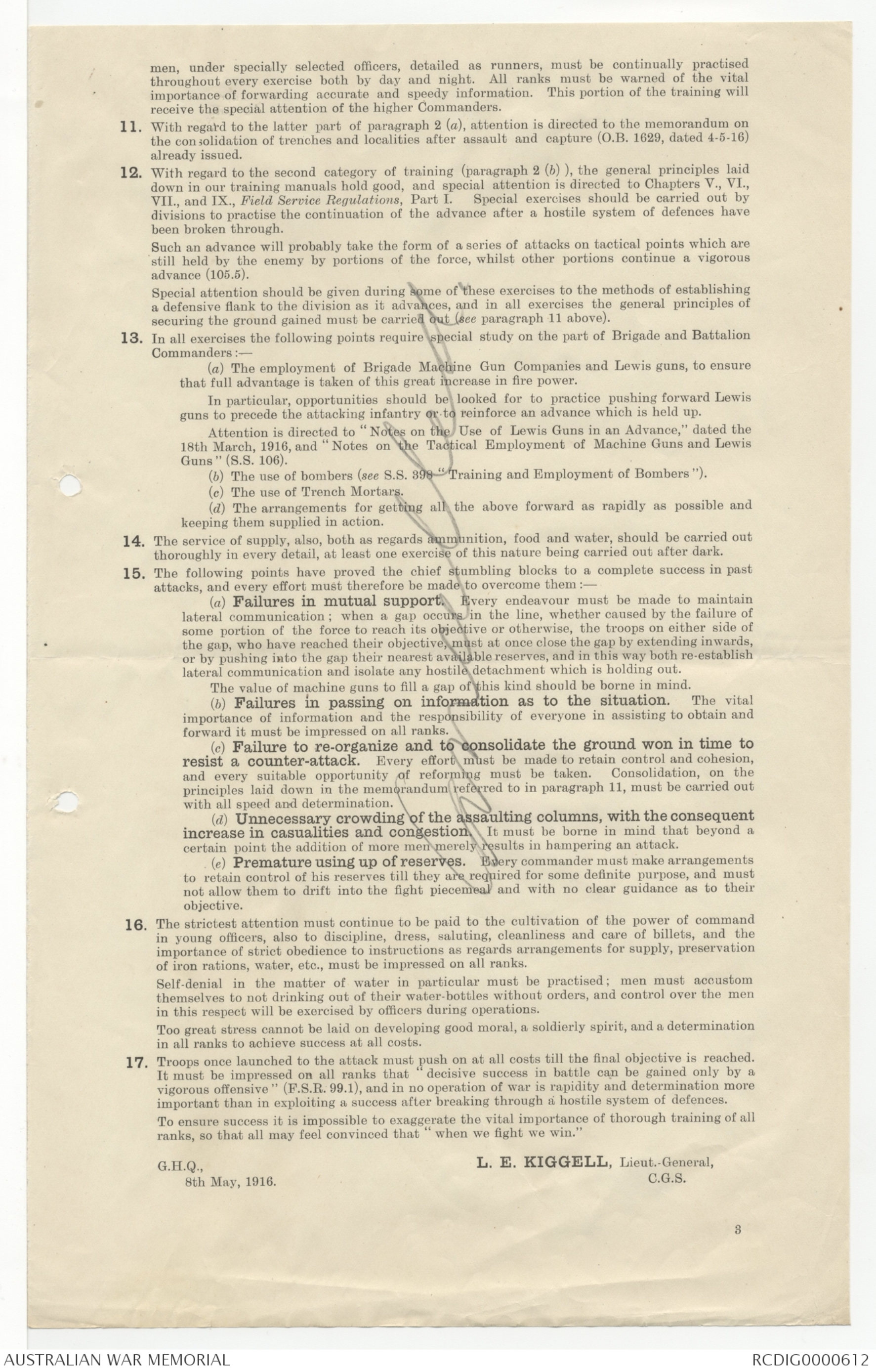
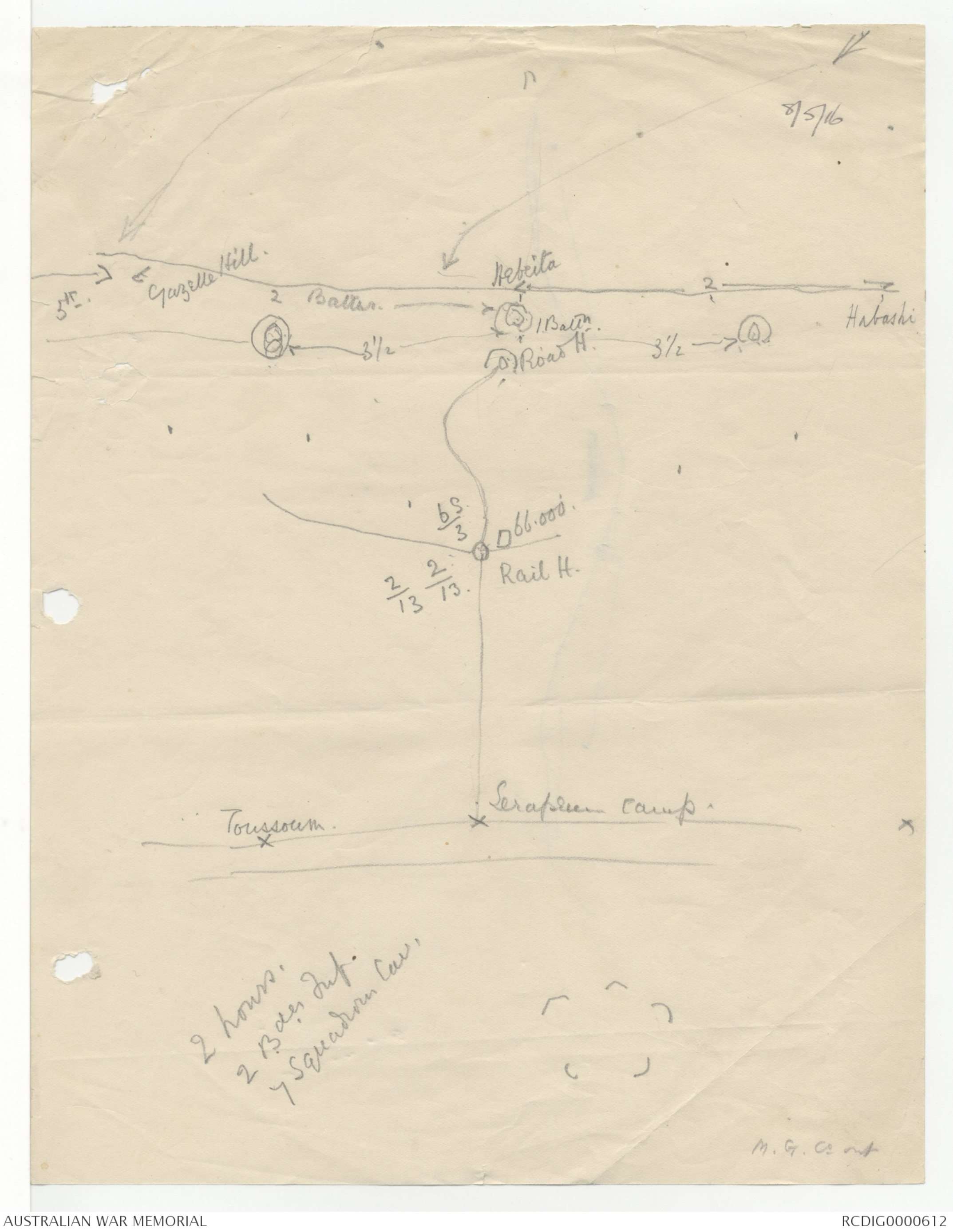
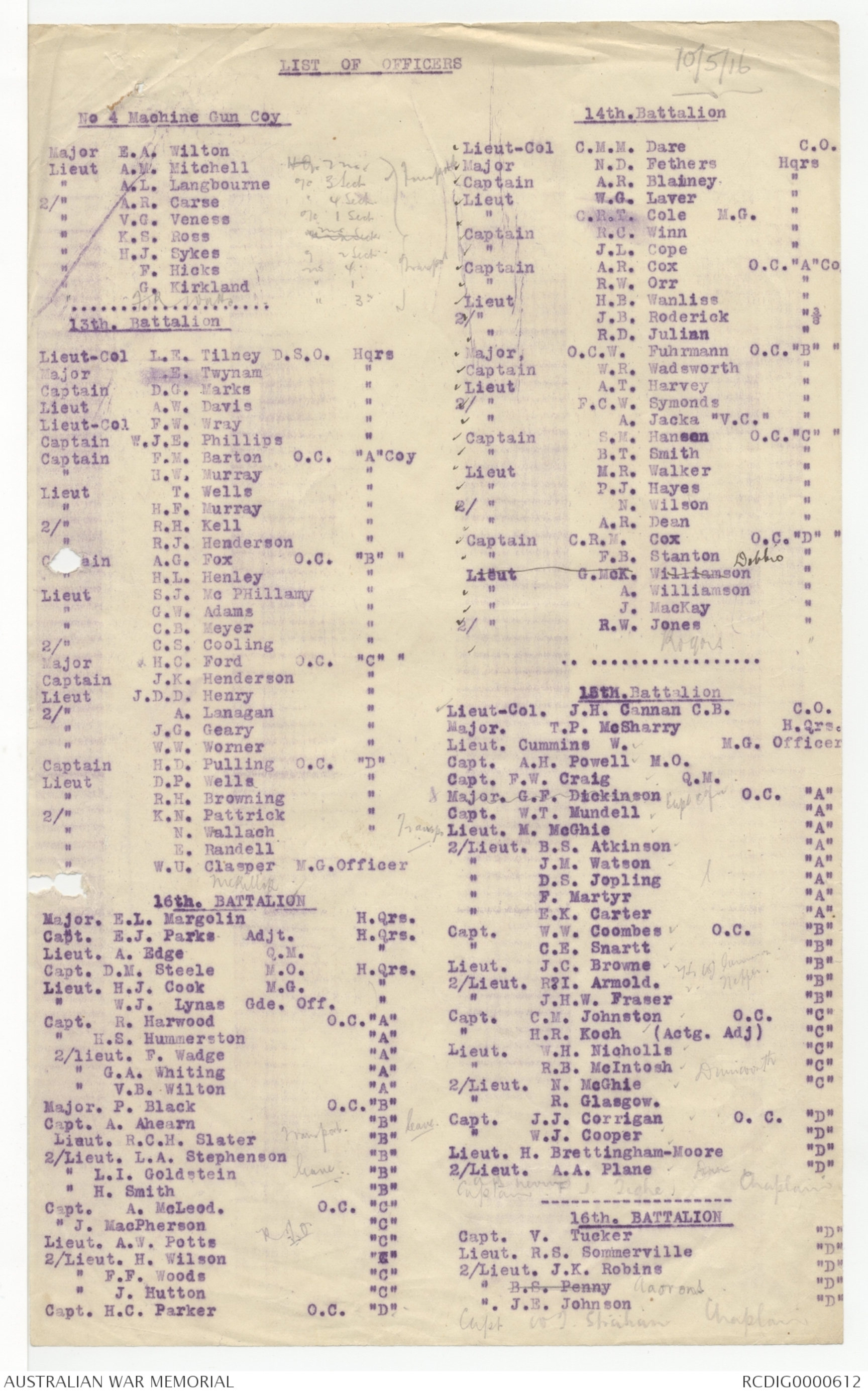

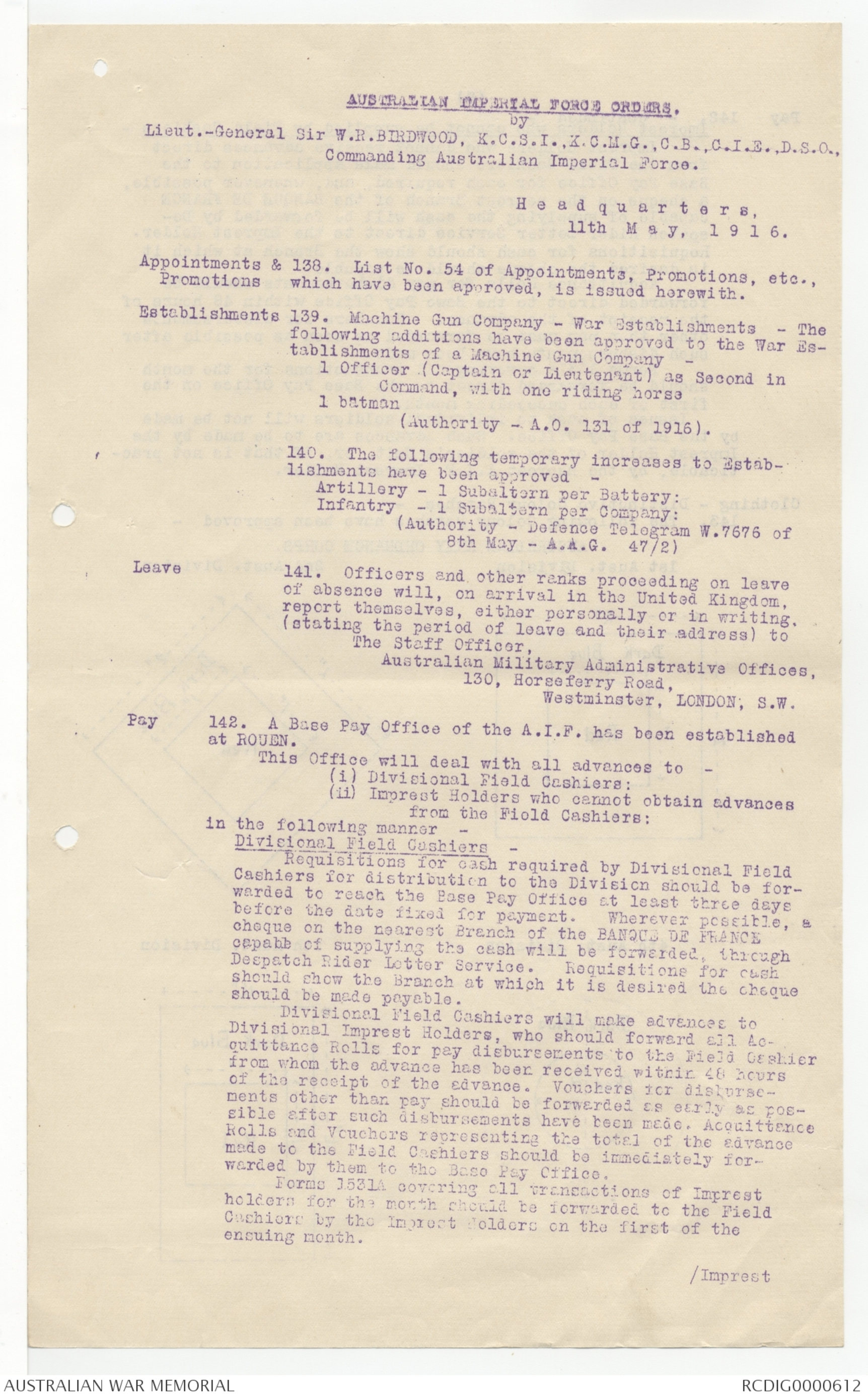
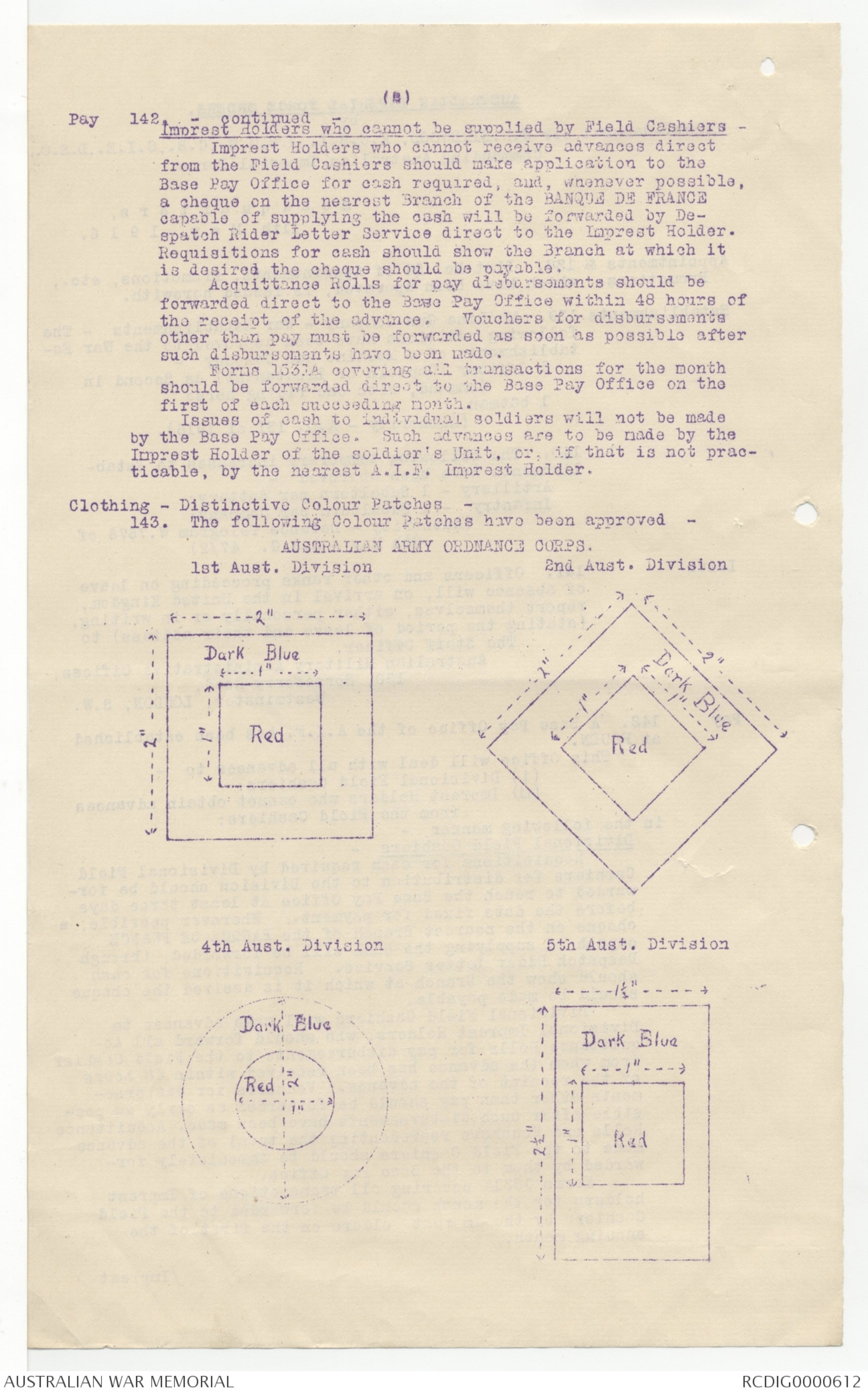
3
A thorough system of good communication throughout the division is of the first
importance, and every kind of alternative form of communication from front to rear, including
parties of men, under specially selected officers, detailed as runners, must be continually
practised throughout every exercise both by day and night. All ranks must be warned of the
vital importance of forwarding accurate and speedy information. This portion of the training
will receive the special attention of the higher Commanders.
11. With regard to the latter part of the paragraph 2 (a), attention is directed to the
memorandum on the consolidation of trenches and localities after assault and capture (O.B.
1629, dated 4-5-16) already issued.
12. With regard to the second category of training (paragraph 2 (b) ), the general principles
laid down in our training manuals hold good, and special attention is directed to Chapters V,
VI, VII, and IX, Field Service Regulations, Part I. Special exercises should be carried out by
divisions to practice the continuation of the advance after a hostile system of defences have
been broken through.
Such an advance will probably take the form of a series of attacks on tactical points which
are still held by the enemy by portions of the force, whilst other portions continue a vigorous
advance (105.5).
Special attention should be given during some of these exercises to the methods of
establishing a defensive flank to the division as it advances, and in all exercises the general
principles of securing the ground gained must be carried out (see paragraph 11 above).
13. In all exercises the following points require special study on the part of Brigade and
Battalion Commanders :-
(a) The employment of Brigade Machine Gun Companies and Lewis guns, to ensure
that full advantage is taken of this great increase in fire power.
In particular, opportunities should be looked for to practice pushing forward Lewis
guns to precede the attacking infantry or to reinforce an advance which is held up.
Attention is directed to " Notes on the Use of Lewis Guns in an Advance," dated the
18th March, 1916, and " Notes on the Tactical Employment of Machine Guns and Lewis
Guns" (S.S. 106).
(b) The use of bombers (see S.S. 398 " Training and Employment of Bombers ").
(c) The use of Trench Mortars.
(d) The arrangements for getting all the above forward as rapidly as possible and
keeping them supplied in action.
14. The service of supply, also, both as regards ammunition, food and water, should be
carried out thoroughly in every detail, at least one exercise of this nature being carried out
after dark.
15. The following points have proved the chief stumbling blocks to a complete success in
past attacks, and every effort must therefore be made to overcome them :-
(a) Failures in mutual support. Every endeavour must be made to maintain lateral
communication ; when a gap occurs in the line, whether caused by the failure of some
portion of the force to reach its objective or otherwise, the troops on either side of the
gap, who have reached their objective, must at once close the gap by extending inwards, or
by pushing into the gap their nearest available reserves, and in this way both re-establish
lateral communication and isolate any hostile detachment which is holding out.
The value of machine guns to fill a gap of this kind should be borne in mind.
(b) Failures in passing on information as to the situation. The vital importance of
information and the responsibility of everyone in assisting to obtain and forward it must
be impressed on all ranks.
(c) Failure to re-organize and to consolidate the ground won in time to resist a
counter-attack. Every effort must be made to retain control and cohesion, and every
suitable opportunity of reforming must be taken. Consolidation, on the principles laid
down in the memorandum referred to in paragraph 11, must be carried out with all speed
and determination.
(d) Unnecessary crowding of the assaulting columns, with the consequent increase in
casualties and congestion. It must be borne in mind that beyond a certain point the
addition of more men merely results in hampering an attack.
(e) Premature using up of reserves. Every commander must make arrangements to
retain control of his reserves till they are required for some definite purpose, and must
not allow them to drift into the fight piecemeal and with no clear guidance as to their
objective.
16. The strictest attention must continue to be paid to the cultivation of the power of
command in young officers, also to discipline, dress, saluting, cleanliness and care of billets,
and the importance of strict obedience to instructions as regards arrangements for supply,
preservation of iron rations, water, etc., must be impressed on all ranks.
Self-denial in the matter of water in particular must be practised ; men must accustom
themselves to not drinking out of their water-bottles without orders, and control over the men
in this respect will be exercised by officers during operations.
Too great stress cannot be laid on developing good moral, a soldierly spirit, and a determination
in all ranks to achieve success at all costs.
17. Troops once launched to the attack must push on at all costs till the final objective
is reached.
It must be impressed on all ranks that " decisive success in battle can be gained only by a
vigorous offensive" (F.S.R. 99.1), and in no operation of war is rapidity and determination more
important than in exploiting a success after breaking through a hostile system of defences.
To ensure success it is impossible to exaggerate the vital importance of thorough training
of all ranks, so that all may feel convinced that " when we fight we win."
G.H.Q.,
L.E. KIGGELL, Lieut.-General,
CGS
8th May, 1916
Diagram - see original document
[*8/5/16*]
[S.S. 109.]
FOR OFFICIAL USE ONLY.
NOT TO BE TAKEN INTO FRONT LINE TRENCHES.
Training of Divisions for Offensive Action.
1. The time available for divisions when out of the line to train as divisions is short. It is
necessary that the utmost use should be made of it, and that the object of the training
should be clearly understood by all concerned.
2. Success depends on preparations for all the phases of an attack, viz.:-
(a) The organisation of trenches for the assembly of the attacking force;
(b) The artillery bombardment;
(c) The crossing of the area between our front trenches and the enemy's;
(d) The capture of the enemy's defensive systems and artillery positions,
and the consolidation against counter-attack of ground won
(e) Exploitation of success.
The training ground must be carefully reconnoitred beforehand, and a detailed programme of
the whole period must be prepared. If possible, every brigade should be exercised in each form
of training.
2. The training of the division can be conveniently divided into two categories:-
(a) Training for the attack from trenches against a hostile system of trenches and
strong points, including the consolidation and occupation of the position won.
(b) Training for exploiting a success when the hostile systems of defence have been
broken through.
3. A complete system of hostile trenches and at least the first line of a second system together
with the defended localities between these two systems, should be marked out on the ground to
full scale from trench maps and aerial photographs, to represent as far as possible an actual
system of trenches and strong points. The assault over the areas so marked out should be
practised several times by the division as a whole; the division being disposed in depth on a
narrow front with two brigades, and also with one brigade in the front line.
A suitable assaulting front for a brigade against a strong objective may be taken at from 400
to 600 yards. The average front of a division forming part of a larger force in an attack,
however, must be governed by the nature of the country to be traversed, the difficulty of the
task allotted, the intervals to be allowed between formations, the number of important
objectives to be assaulted, and the number of brigades to be employed in the front line. It may
be taken at from 1,000 to 1,800 yards, or an average of about 1,500 yards for several divisions
in a decisive attack.
4. The attack must aim at continuity and must be driven home without intermission, so that the
attack gradually works forward till the endurance of the enemy is broken down.
Every attacking unit must be given a limited and clearly defined objective, which it is to
capture and consolidate at all costs; the assaulting columns must go right through above
ground to this objective in successive waves or lines, each line adding fresh impetus to the
preceding line when this is checked, and carrying the whole forward to the objective. The
cleaning up and consolidation of positions passed over by the assaulting columns in their
advance, the formation of protective flanks, and the preparation of strong supporting points in
the captured area will be carried out by other troops of the attacking force, following the
assaulting columns and specially told off for the purpose. Local reserves must be held to
reinforce those parts of the line which are checked, to fill gaps opening in the front and to
relieve troops which are exhausted and whose endurance has gone.
From the moment when the first line of assaulting troops leaves our front trenches, a
continuous forward flow must be maintained from the rear throughout the division. Up to
our own front line this flow may be either above or below ground, according to topographical
conditions, the nature of the enemy's fire, and the number of communication trenches available,
but once the assaulting troops have left our trenches and are pushing on to their objective,
their movement will be carried out above ground.
The movement of the Divisional Reserve may be controlled when required by ordering beforehand
that its forward flow is to be checked on reaching some definite line (such as our original
first line of trenches), in which it will await orders.
5. When a particular line or succession of lines have reached an objective assigned to them, for
the consolidation of which preparations have already been made, it will usually be inadvisable
to order these troops to push on to a further objective. It follows, therefore, that, to secure
continuity in operations on a large scale, it may be necessary to arrange for fresh troops to pass
through others.
Occasions may also occur in which there is, beyond the first objective, a second objective e.g.,
another system of hostile trenches or centre of resistance, which the Commander of the
formation intends to attack, conditionally on the first attack succeeding, with a fresh body of
troops, but as part of the same operation.
Divisions must, therefore, be practised in the passing of a fresh body of attacking troops
through the troops which have carried out the first assault and have reached their objective.
The second attack will be carried out on the same principles, the assaulting columns going
straight through to the objective in successive lines.
The passing of one body of troops through another during an attack is, however, an extremely
difficult operation, and should only be attempted when there is a reasonable opportunity
of seizing and holding the second objective by immediate attack, as for instance
when the first attacking force has succeeded in gaining the whole objective it was ordered to
consolidate, the artillery preparation on the second objective has been adequate and effective,
and the force detailed to attack it is well in hand.
[*cancelled*]
The conditions of every attack vary, however, and a special solution must be found for
each individual problem. It depends on whether the furthest objective that has been allotted
to a division can be reached in one continuous advance, or whether it is necessary to
capture and consolidate some intermediate objective before the final one can be assaulted.
6. With regard to the above, it is impossible to lay down any definite rules as to the strength
of assaulting columns, the number of lines of which they consist, or the distance apart of
these lines.
The depth of the assaulting column depends on the distance of the objective, and on the
opposition that has to be overcome in reaching it. Its strength must be calculated so as to
give sufficient driving power to enable the column to reach its objective and to provide sufficient
remaining energy to enable the objective to be held when gained. The distance apart of the
lines will usually be regulated by the rate at which the successive lines can be formed up and
moved forward over the parapet. The men in each line should be extended at two or three
paces interval. In this connection it is worthy of consideration that in many instances
experience has shown that to capture a hostile trench a single line of men has usually failed,
two lines have generally failed but sometimes succeeded, three lines have generally succeeded
but sometimes failed, and four or more lines have usually succeeded.
7. In these exercises the attack or part of it should frequently fail to reach its objective, and the
commanders of the units thus checked be confronted on the spot with a new situation and
practised in making rapid decisions based on the original plan.
Every brigade in turn should be called upon to move from reserve to the capture of an objective,
in front of which the assaulting troops have been held up, or against which an attack has
failed. The orders for this operation and a description of the artillery support that will be
available will be given to Commanders on the spot.
8. Any division may be in reserve to one or more assaulting divisions. Such a task requires as
careful previous preparation and study as does the task of the divisions actually detailed for
the assault.
The staffs and regimental officers of the division in reserve on any portion of the assaulting
front must make themselves familiar by personal reconnaissance with the trench systems over
which they may have to operate and with every detail of the ground. They must be provided
with the same maps as those used by the assaulting division. The Staffs and higher
Commanders of the division in reserve must study the plans and preparations of the assaulting
divisions as closely as if they were their own. In this way only will they be able when the
time comes to take up the attack without hesitation, and with a clear understanding of the
task before them.
From the moment the operation beings, the closest liaison must be established, in accordance
with arrangements made beforehand; and responsible Staff Officers from the Reserve Division
should be attached to the Headquarters of the Divisions in front so as to follow every
development of the action. As soon as it is known where the reserve division is to be put in,
the proper place for the Commander of the Reserve Division and his Staff is at the Battle
Headquarters of the Division Commander, who is controlling the operations in that particular
portion of the battlefield.
9. Special exercises should be held during the period of training by Divisional and Brigade
Commanders with all their staffs and subordinate commanders--
(a) To consider in detail the preliminary arrangements for an attack on a large scale;
and
(b) To consider the action to be taken by subordinate commanders when local unexpected
situations arise, such as occur when a portion of a line is held up, impassable obstacles are
encountered, or it becomes necessary to deliver or repel a local counter-attack.
With regard to (a), attention is direction to the memorandum on the preliminary arrangements
in case of a large attack, issued with O. B./1207, dated the 2nd February, 1916. The artillery
programme and co-operation should be worked out in all exercises and explained to all
concerned.
With regard to (b), it must be remembered that officers and troops generally do not now possess
that military knowledge arising from a long and high state of training which enables them to
act promptly on sound lines in unexpected situations. They have become accustomed to
deliberate action based on precise and detailed orders.
Officers and men in action will usually do what they have been practised to do or have been told
to do in certain situations, and it is therefore all the more necessary to ensure that a clear
understanding should exist among all ranks as to what action is to be taken in the different
situations that may arise in battle. In this connection every endeavour should be made to
inculcate mutual confidence and the spirit of combination directly towards the achievement of
the task set. During an advance under fire men must possess the habit of looking
spontaneously to their leaders for direction; more often than not leaders have to look for and
find their men. Even this in itself is not sufficient. Situations will constantly arise when
there is no officer or non-commissioned officer present with groups of men, and the men must
realise that, in such a case, one man must assume leadership on the spot and remainder act
under his control.
All must be prepared for heavy casualties, and must realize that the magnitude of the interests
at stake necessitate the greatest self-sacrifice from one and all.
10. Brigade Headquarters, as well as Battalion Headquarters, must be practised in moving forward
during the progress of an attack, and it is essential that communication from front to rear must
not be lost. It is, therefore, necessary that the route to be followed by Headquarters should be
well defined and known, so that runners both from front and rear will known the route to follow
in order to pick up the Headquarters should it be moving. In the case of Brigade and Battalion
Headquarters it will usually be inadvisable to state a place to which the Headquarters will move,
as that place may be inaccessible or untenable.
A thorough system of good communication throughout the division is of the first importance
and every kind of alternative form of communication from front to rear, including parties of
2
men, under specially selected officers, detailed as runners, must be continually practiced
throughout every exercise both by day and night. All ranks must be warned of the vital
importance of forwarding accurate and speedy information. This portion of the training will
receive the special attention of the higher Commanders.
11. With regard to the latter part of paragraph 2 (a), attention is directed to the memorandum on
the consolidation of trenches and localities after assault and capture (O.B.1629, dated 4-5-16)
12. With regard to the second category of training (paragraph 2 (b) ). the general principles laid
down in our training manuals hold good, and special attention is directed to Chapters V., VI.,
VII., and IX., Field Services Regulations, Part I. Special exercises should be carried out by
divisions to practice the continuation of the advance after a hostile system of defenses have
been broken through.
Such an advance will probably take the form of a series of attacks on tactical points which are
still head by the enemy by portions of the force, whilst other portions continue a vigorous
advance (105.5).
Special attention should be given during some of these exercises to the methods of establishing
a defensive flank to the divisions as it advances, and in all exercises the general principles of
securing the ground gained must be carried out (see paragraph 11 above).
13. In all exercises the following points require special study on the part of Brigade and Battalion
Commanders:-
(a) The employment of Brigade Machine Gun Companies and Lewis guns, to ensure
the full advantage is taken of this great increase in fire power.
In particular, opportunities should be looked for to practice pushing forward Lewis
guns to procede the attacking infantry or to reinforce an advance which is held up.
Attention is directed to "Notes on the Use of the Lewis Guns in an Advance," dated the
18th March, 1916, and "Notes on the Tactical Employment of Machine Guns and Lewis
Guns" (S.S.106).
(b) The use of bombers (see S.S. 398 "Training and Employment of Bombers").
(c) The use of Trench Mortars.
(d) The arrangements for getting all the above forward as rapidly as possible and
keeping them supplied in action.
14.The service of supply, also, both as regards ammunition, food and water, should be carried out
thoroughly in every detail, at least one exercise of this nature being carried out after dark.
15. The following points have proved the chief stumbling blocks to a complete success in past
attacks, and every effort must therefore be made to overcome them:-
(a) Failure in mutual support. Every endeavour must be made to maintain
lateral communication; when a gap occurs in the line, whether caused by the failure of
some portion of the force to reach the objective or otherwise, the troops on either side of
the gap, who have reached their objective, must at once close the gap by extending inwards,
or by pushing into the gap their nearest available reserves, and in this way both re-establish
lateral communication and isolate any hostile detachment which is holding out.
The value of machine guns to fill in a gap of this kind should be borne in mind.
(b) Failure in passing on information as to the situation. The vital
importance of information and the responsibility of everyone in assisting to obtain and
forward it must be impressed on all ranks.
(c) Failure to re-organise and to consolidate the ground won in time to
resist a counter-attack. Every effort must be made to retain control and cohesion,
and every suitable opportunity of reforming must be taken. Consolidation, on the
principles laid down in the memorandum referred to in paragraph 11, must be carried out
with all speed and determination.
(d) Unnecessary crowding of the assaulting columns, with the consequent increase in causalities and congestion. It must be borne in the mind that beyond a
certain point the addition of more men merely results in hampering an attack.
(c) Premature using up of reserves. Every commander must make arrangements
to retain control of his reserves till they are required for some definite purpose, and must
not allow them to drift into the fight piecemeal and with no clear guidance as to their objective.
16. The strictest attention must continue to be paid to the cultivation of the power of command
in young officers, also to discipline, dress, saluting, cleanliness and care of billets, and the
importance of strictest obedience to instructions as regards arrangements for supply, preservation
of iron rations, water, etc., must be impressed on all ranks.
Self-denial in the matter of water in particular must be practiced: men must accustom
themselves to not drinking out of their water-bottles without orders, and control over the men
in this respect will be exercised by officers during operations.
Too great stress cannot be laid on developing good moral, a soldierly spirit, and a determination
in all ranks to achieve success at all costs.
17. Troops once launched to the attack must push on at all costs till the final objective is reached.
It must be impressed on all ranks that "decisive success in battle can be gained only by a
vigorous offensive "(F.S.R. 99.1), and in no operation of war is rapidity and determination more
important than in exploiting a success after breaking through a hostile system of defenses.
To ensure success it is impossible to exaggerate the vital importance of thorough training of all
ranks, so that all may feel convinced that "when we fight we win."
[*cancelled*]
L. E. KIGGELL, Lieut. General,
C.G.S.
G.H.Q.,
8th May, 1916.
3
Diagram - see original document
LIST OF OFFICERS
10/5/16
| No 4 Machine Gun Coy | |||
| Major | E.A. Wilton | ||
| Lieut | A.M. Mitchell | HQ 2 [[?]] | Transport |
| '' | A.L. Langbourne | o/c 3 Sect | |
| 2/'' | A.R. Carse | " 4 Sect | |
| '' | V.G. Veness | o/c 1 Sect | |
| '' | K.S. Ross |
MG Sectn | |
| '' | H.J. Skyes | o/ 2 Sect | |
| '' | F. Hicks | ns 4 " | Transport |
| '' | G. Kirkland | " 1 " | |
| '' | F.R. Watts | " 3 " | |
| 13th. Battalion | |||
| Lieut-Col | L.E. Tilney | D.S.O | Hqrs |
| Major | L.E. Twynam | " | |
| Captain | D.G. Marks | " | |
| Lieut | A.W. Davis | " | |
| Lieut-Col | F.W. Wray | " | |
| Captain | W.J.E. Phillips | " | |
| Captain | F.M. Barton | O.C. | "A" Coy |
| " | H.W. Murray | " | |
| Lieut | T. Wells | " | |
| " | H.F. Murray | " | |
| 2/ " | R.H. Kell | " | |
| " | R.J. Henderson | " | |
| Captain | A.G. Fox | O.C. | "B" " |
| " | H.L. Henley | " | |
| Lieut | S.J. Mc PHillamy | " | |
| " | G.W. Adams | " | |
| " | C.B. Meyer | " | |
| 2/ " | C.S. Cooling | " | |
| Major | H.C. Ford | O.C. | "C" " |
| Captain | J.K. Henderson | " | |
| Lieut | J.D.D. Henry | " | |
| 2/ " | A. Lanagan | " | |
| " | J.G. Geary | " | |
| " | W.W. Worner | " | |
| Captain | H.D. Pulling | O.C. | "D" " |
| Lieut | D.P. Wells | " | |
| " | R.H. Browning | " | |
| 2/" | K.N. Pattrick | " | |
| " | N. Wallach | " | |
| " | E. Randell | ||
| W.U. Clasper | M.G. Officer | ||
| McKillop | |||
| 14th. Battalion | |||
| Lieut-Col | C.M.M. Dare | C.O. | |
| Major | N.D. Fethers | Hqrs | |
| Captain | A.R. Blainey | " | |
| Lieut | W.G. Laver | " | |
| " | C.R.T. Cole | M.G. | " |
| Captain | R.C. Winn | " | |
| " | J.L. Cope | " | |
| Captain | A.R. Cox O.C | O.C. | "A" Coy |
| " | R.W. Orr | " | |
| Lieut | H.B. Wanliss | " | |
| 2/ " | J.B. Roderick | " 3/8 | |
| " | R.D. Julian | " | |
| Major | O.C.W. Fuhrmann | O.C. | "B" " |
| Captain | W.R. Wadsworth | " | |
| Lieut | A.T. Harvey | " | |
| 2/ " | F.C.W. Symonds | " | |
| " | A. Jacka | "V.C." | " |
| Captain | S.M. Hansen | "C" " | |
| " | B.T.Smith | " | |
| Lieut | M.R Walker | " | |
| " | P.J. Hayes | " | |
| 2/ " | N. Wilson | " | |
| " | A.R. Dean | " | |
| Captain | C.R.M. Cox | "D" " | |
| " | F.B. Stanton | " | |
| [*Dobbio*] | " | ||
| " | A. Williamson | " | |
| " | J. MacKay | " | |
| 2/ " | R.W. Jones | " | |
| Rogers | " | ||
| 15th Battalion | |||
| Lieut-Col | J.H. Cannan | C.B. | C.O. |
| Major. | T.P. McSharry | H.Qrs. | |
| Lieut. | Cummins W. | M.G.Officer | |
| Capt. | A.H. Powell | M.O. | |
| Capt. | F.W. Craig | Q.M. | |
| Major. | O.C. [*Capt of ?*] | "A" | |
| Capt. | W.T Mundell | "A" | |
| Lieut. | M. McGhie [*Transport*] | "A" | |
| 2/Lieut. | B.S. Atkinson | "A" | |
| " | J.M. Watson | "A" | |
| " | D.S. Jopling | "A" | |
| " | F. Martyr | "A" | |
| " | E.K. Carter | "A" | |
| Capt. | W.W. Coombes | O.C. | "B" |
| " | C.E. Snartt | "B" | |
| Lieut. | J.C. Browne | [*2Lt WJ Gunison*] | "B" |
| 2/Lieut. | R?.I. Arnold | [* " " Neffer*] | "B" |
| " | J.H.W. Fraser | "B" | |
| Capt | C.M.Johnston | O.C. | "C" |
| " | H.R. Koch | (Actg. Adj) | "C" |
| Lieut. | W.H. Nicholls | "C" | |
| " | R.B. McIntosh | [*D Winworth*] | "C" |
| 2/Lieut. | N. McGhie | "C" | |
| " | R. Glasgow. | ||
| Capt. | J.J. Corrigan | O.C. | "D" |
| " | W.J. Cooper | "D" | |
| Lieut. | H. Brettingham-Moore | "D" | |
| 2/Lieut. | A.A. Plane | "D" | |
| [*A.B. Neving*] | [*?*] | "D" | |
| Chaplin | [*F J Tiche*] | [*Chaplain*] | "D" |
| 16th. BATTALION | |||
| Major. | E.L. Margolin | H.Qrs. | |
| Capt. | E.J. Parks | Adjt | H.Qrs. |
| Lieut. | A.Edge | Q.M. | " |
| Capt. | D.M. Steele | M.O. | H.Qrs. |
| Lieut. | H.J. Cook | M.G. | " |
| " | W.J. Lynas | Gde. Off. | " |
| Capt. | R. Harwood | O.C. | "A" |
| " | H.S. Hummerston | "A" | |
| 2/Lieut. | F. Wadge | "A" | |
| " | G.A. Whiting | "A" | |
| " | V.B. Wilton | "A" | |
| Major. | P. Black | O.C. | "B" |
| Capt. | A. Ahearn | [*leave*] | "B" |
| Lieut. | R.C.H. Slater | [*'Transport*] | "B" |
| 2/Lieut | L.A. Stephenson | "B" | |
| " | L.I. Goldstein | [*leave*] | "B" |
| " | H. Smith | "B" | |
| Capt. | A. McLeod | O.C. | "C" |
| " | J. MacPherson | O.C | "C" |
| Lieut. | A.W. Potts | [*R of ?] | "C" |
| 2/Lieut. | H. Wilson | "C" | |
| " | F.F. Woods | "C" | |
| " | J. Hutton | "C" | |
| Capt. | H.C. Parker | O.C. | "D" |
| Capt. | V. Tucker | "D" | |
| Lieut. | R.S. Sommerville | "D" | |
| 2/Lieut. | J.K.Robins | "D" | |
| " | "D" | ||
| " . | J.E. Johnson | "D" | |
| Capt | [*W J Strahan*] | [*Chaplain*] | "D" |
ORDERS FOR A.M.C.
4TH Division.
by Lieut-Col. G.W. Barber, A.D.M.S. 4th Division.
13th FIELD AMBULANCE.
O.C. will establish a Dressing station at Roadhead
at the point where the road to the left junctions with
the main road. The sphere of action of this station
will extend from and inclusive of Camp 3 to Camp 57.
One Sand cart can be kept at Gebel Habeita Camp, the
remainder (5) with Camels and Cacolets kept ready at
the Dressing Station to proceed to any point required
in this area. Patients will be evacuated to the 13th
Field Ambulance at Railhead by returning supply
Waggons, Ambulance Waggons or other transport.
12th FIELD AMBULANCE.
O.C. will be prepared to establish an Advanced
Dressing Station at a spot in rear of Post 7 and the
sphere of action for this station will extend from
Camp 3 to the left flank. Patients will be
evacuated either by return supply waggons from the end
of the left road or direct to Railhead by Camels to
the 12th field Ambulance. One sand cart can be kept
at Camp 7 if necessary.
4th FIELD AMBULANCE.
O.C. must be prepared to send his Camel Transport
with a few Bearers to evacuate patients from and
inclusive of Camp 57 to Camp 62 to Railhead. For the
precent this line will be served by the 12th Field
Ambulance who have a Sand cart at Camp 58 until
relieved by the 4th Field Ambulance.
3rd L.H. FIELD AMBULANCE.
O.C. will have his Desert Ambulance and Convey
ready to proceed with the Column. The Mounted
Bearers will be ready to co-operate with the Light
Horse at Railhead and if necessary will remove their
patients by Sand Carts or Camels which they must
obtain by application to Dressing Stations before
mentioned. The Horsed Ambulance will be kept in
readiness to evacuate patients from Road or Railhead
to the 54th C.C.S.
NOTE.
As far as possible the horsed Ambulances of the 12th
and 13th Field Ambulance will be kept in readiness to
assist in the evacuation of patients from Road or
Railhead to the 54th C.C.S.
Arrangements will also be made for the 12th and 13th
Field Ambulances to evacuate into the train which will
take patients to the 54th C.C.S.
GW Barber
Lieut-Colonel.
A.D.M.S.
4th Division.
A.D.M.S.
Date 11/5/16
A.I.F 4th Division.
Copies to:-
G.O.C. 4th Division.
G.O.C. Railhead.
G.O.C. 4th Brigade.
G.O.C. 12th Brigade.
G.O.C. 13th Brigade.
C.D.A.
D.D.M.S. 2nd Anzac.
O.C. 54th C.C.S.
O.C. 4th Field Amb.
O.C. 12th Field Amb.
O.C. 13th Field Amb.
O.C. 3rd L.H. Field Amb.
[*A.D.M.S
No......
Date 11/5/16
4th DIVISION, A.I.F.*]
AUSTRALIAN IMPERIAL FORCE ORDERS.
by
Lieut.-General Sir W.R. BIRDWOOD. K.C.S.I., K.C.M.G.., C.B.,C.I.E.,D.S.O.,
Commanding Australian Imperial Force.
Headquarters
11th May, 1916
Appointments & Promotions
138. List No. 54 of Appointments, Promotions, etc.,
which have been approved, is issued herewith.
Establishments
139. Machine Gun company - War Establishments - The
following additions have been approved to the War Establishments
of a Machine Gun Company -
1 Officer (Captain or Lieutenant) as Second in
Command, with one riding horse
1 batman
(Authority - A.O. 131 of 1916)
140. The following temporary increases to Establishments
have been approved -
Artillery - 1 Subaltern per Battery:
Infantry - 1 Subaltern per Company:
(Authority - Defence Telegram W.7676 of
8th May - A.A.C. 47/2)
Leave
141. Officers and other ranks proceeding on leave
of absence will, on arrival in the United Kingdom,
report themselves, either personally or in writing.
(stating the period of leave and their address) to
The Staff Officer,
Australian Military Administrative Offices,
130, Horseferry Road,
Westminster, London, S.W.
Pay
142. A Base Pay Office of the A.I.F. has been established
at ROUEN.
This office will deal with all advances to -
(i) Divisional Field Cashiers:
(ii) Imprest Holders who cannot obtain advances
from the Field Cashiers:
in the following manner -
Divisional Field Cashiers -
Requestions for cash required by Divisional Field
Cashiers for distribution to the Division should be forwarded
to reach the Base Pay Office at least three days
before the date fixed for payment. Wherever possible, a
cheque on the nearest Branch of the BANQUE DE FRANCE
capable of suppling the cash will be forwarded, through
Despatch Rider Letter Service. Requestions for cash
should show the Branch at which it is desired the cheque
should be made payable.
Divisional Field Cashiers will make advances to
Divisional Imprest Holders, who should forward all Acquittance
Rolls for pay disbursements to the Field Cashier
from whom the advance has been received within 48 hours
of the receipt of the advance. Vouchers for disbursements
other than pay should be forwarded as early as possible
after such disbursements have been made. Acquittance
Rolls and Vouchers representing the total of the advance
made to the Field Cashiers should be immediately forwarded
by them to the Base Pay Office.
Forms 1531A covering all transactions of Imprest
holders for the month should be forwarded to the Field
Cashiers by the Imprest Holders on the first of the
ensuing month.
/Imprest
(2)
Pay
142, - continued -
Imprest Holders who cannot be supplied by Field Cashiers-
Imprest Holders who cannot receive advances direct
from the Field Cashiers should make application to the
Base Pay Office for cash required, and whenever possible,
a cheque on the nearest Branch of the BANQUE DE FRANCE
capable of suppling the cash will be forwarded by Despatch
Rider Letter Service direct to the Imprest Holder.
Requisitions for cash should show the Branch at which it
is desired the cheque should be payable.
Acquittance Rolls for pay disbursements should be
forwarded direct to the Base Pay Office within 48 hours of
the receipt of the advance. Vouchers for disbursements
other than pay must be forwarded as soon as possible after
such disbursements have been made.
Forms 1531A covering all transactions for the month
should be forwarded direct to the Base Pay Office on the
first of each succeeding month.
Issues of cash to individual soldiers will not be made
by the Base Pay Office. Such advances are to be made by the
Imprest Holder of the soldier's unit, or, if that is not practicable,
by the nearest A.I.F. Imprest holder.
Clothing - Distinctive Colour Patches -
143. The following Colour Patches have been approved -
AUSTRALIAN ARMY ORDNANCE CORPS.
Diagram - see original document
 Deb Parkinson
Deb ParkinsonThis transcription item is now locked to you for editing. To release the lock either Save your changes or Cancel.
This lock will be automatically released after 60 minutes of inactivity.